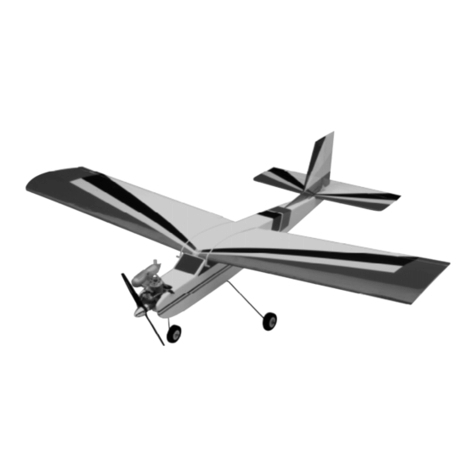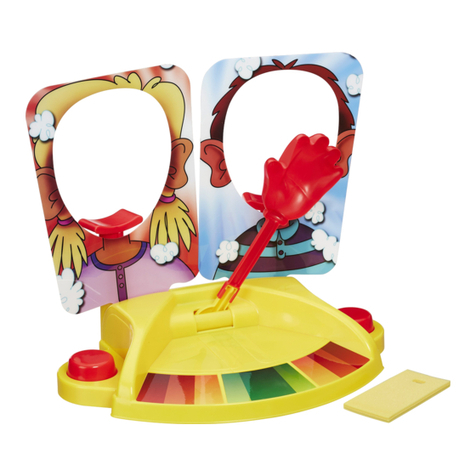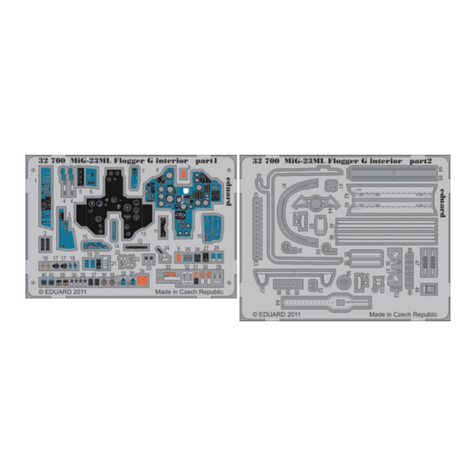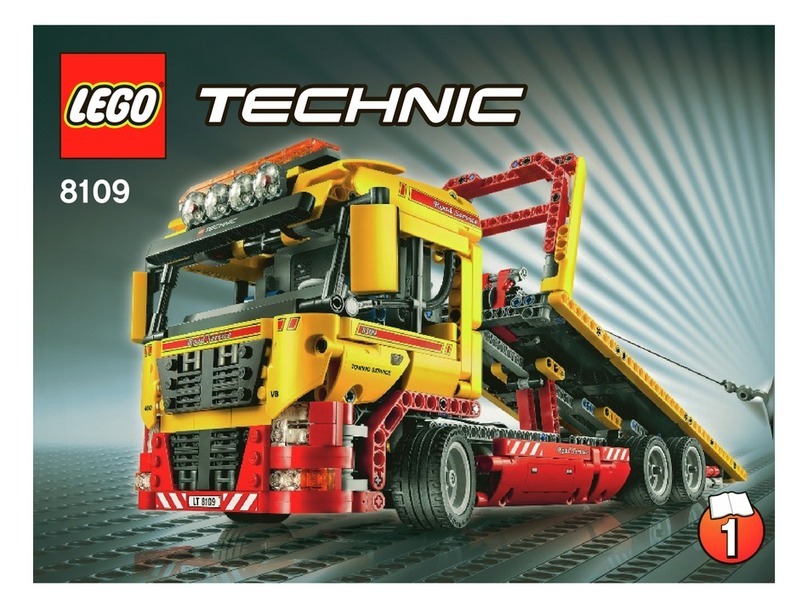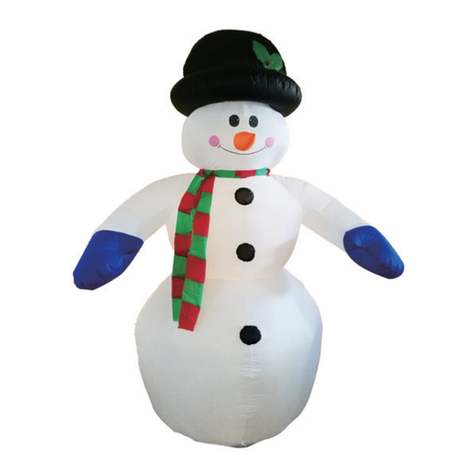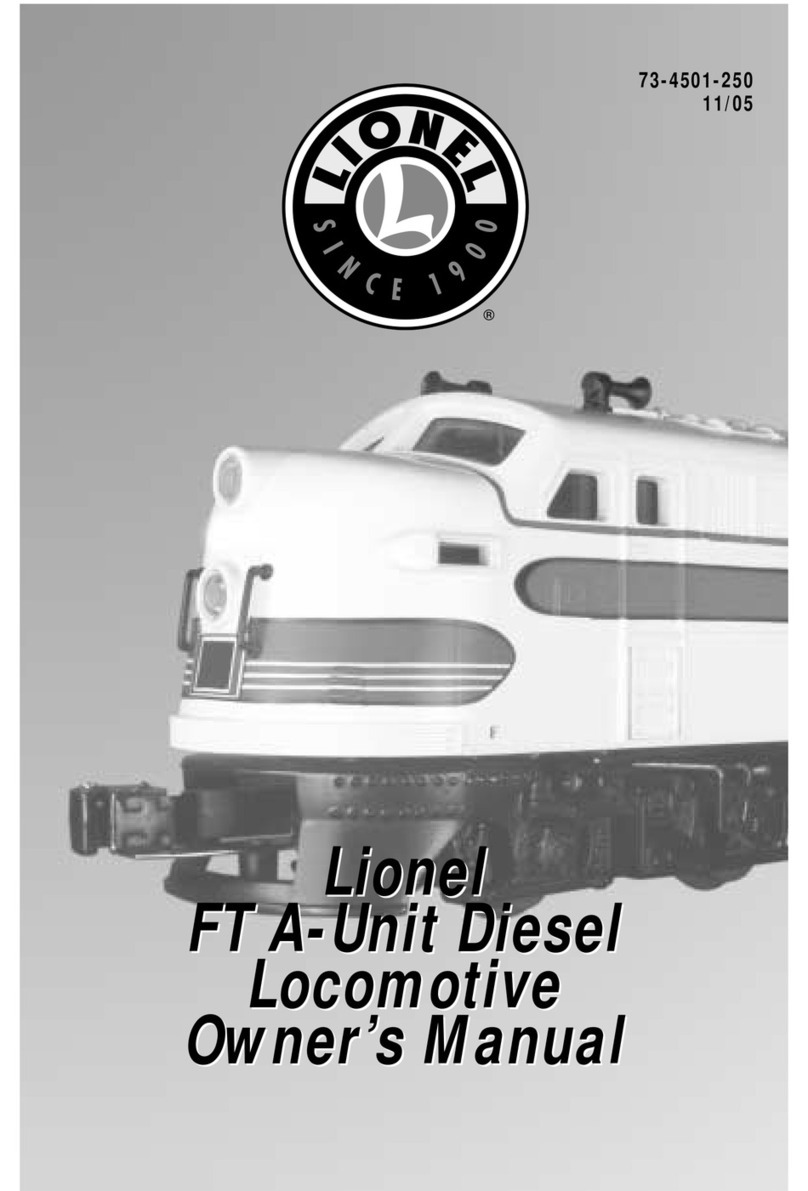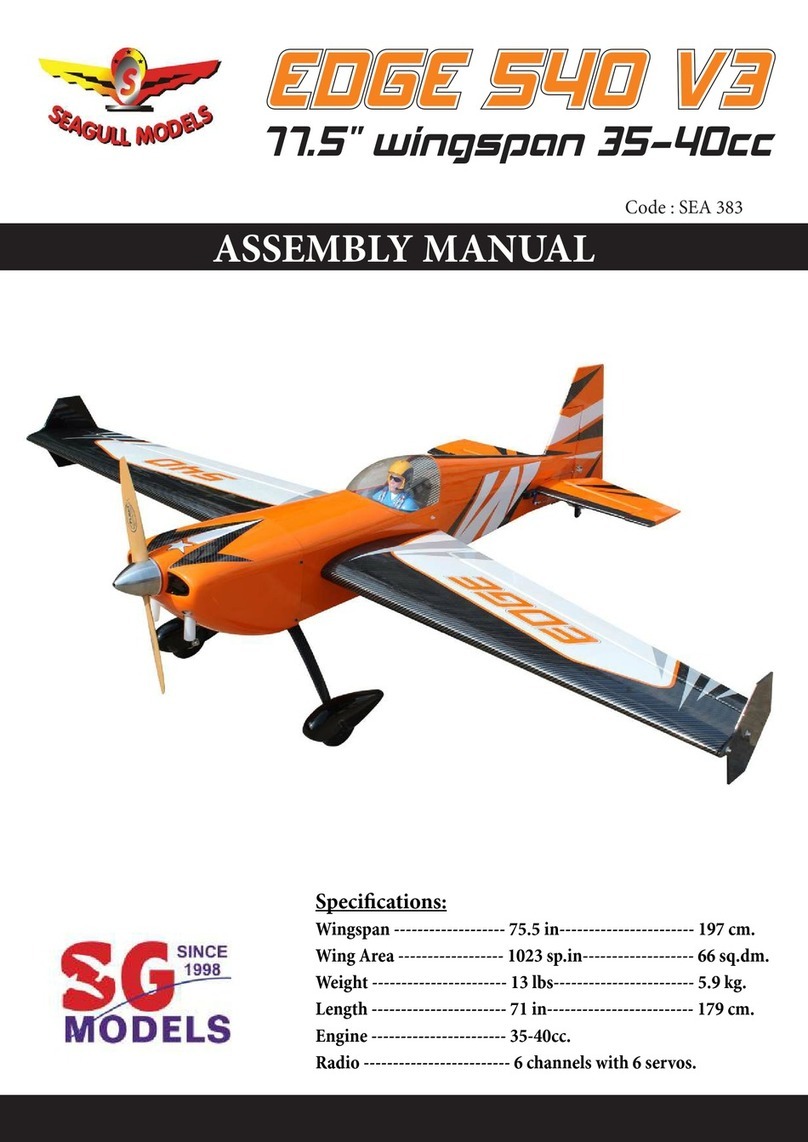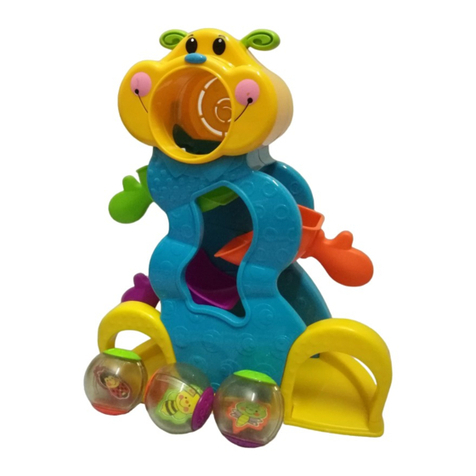Global Ultimate User manual

1
Instructions for Final Assembly
WouldyouliketoflyyourownUltimateBiplane? Doyouwanttobeflyinginaweekend?
Areyoureadyforanaerobatic 46sizeperformancebiplane? Then you’vechosenwisely.
TheGlobalARFUltimatewasmadeforyou. Featureslikeanallbalsaandplywoodbuiltup
airframe,justlikeyou'd do it yourself fromakit. Agenerous tail section combined witha
longfuselagemomentandsweptwingsmakethisanaerobaticperformerthatyou'llalways
wanttofly. Asuperstrongmetalwing centercabanesystemwithouterplywoodinterplane
strutsholdeverythingtogetherwhenyou'reperformingsnaprollsandinvertedspins. Togo
alongwiththiswe'veprovided aprepaintedfourcolorcowling,prepaintedwheelpantsand
a clear molded canopy. There is no other aerobatic biplane in it's class that is easier to
assembleorthatflysbetter. Weknowyou’llenjoybuildingtheUltimate,butyouboughtthis
airplane to fly. And that's what it does best. Set up for sport flying, it’s predictable and
tracks like it's on rails. Deceivingly easy to fly, change the set-up parameters and you’ll
pushtheenvelopelikeanexperiencedairshowperformer. Completeinvertedflatspinsand
torquerollslikeyou’veneverperformedbefore!
Version V1.0 3-99 Kit # 123820 All Contents © Copyright 1999
.46 SIZE AEROBATIC ARF PERFORMANCE BIPLANE.46 SIZE AEROBATIC ARF PERFORMANCE BIPLANE
.46 SIZE AEROBATIC ARF PERFORMANCE BIPLANE.46 SIZE AEROBATIC ARF PERFORMANCE BIPLANE
.46 SIZE AEROBATIC ARF PERFORMANCE BIPLANE

2
TABLE OF CONTENTS
To make your modeling experience totally enjoyable, we recommend that you get experienced, knowledgable
help with assembly and during your first flights. Your local hobby shop has information about flying clubs in
your area whose membership includes qualified instructors. You can also contact the AMA at the address below.
Academy of Model Aeronautics
5151 East Memorial Drive
Muncie, IN. 47302-9252
(800) 435-9262
www.modelaircraft.org
Global guarantees this kit to be free from defects in both material and workmanship, at the date of purchase. This does
not cover any components parts damaged by use, misuse or modification. In nocaseshallGlobal's liabilityexceed the
originalcostof thepurchasedkit.
In that Global has no control over the final assembly or material used for final assembly, no liability shall be assumed
for any damage resulting from the use by the user of the final user-assembled product. By the act of using the final
user-assembled product, the user accepts all resulting liability.
Kit Contents....................................................2
Additional Items Required...............................3
Tools and Supplies Needed..............................3
Field Support Equipment Needed.....................3
Metric Conversion Chart..................................3
Bottom Wing Mounting...................................4
Align the Bottom Wing.............................4
Installing the Blind Nuts...........................4
Installing the Wing Bolt Doubler...............5
Installing the Wing....................................5
Horizontal Stabilizer Mounting........................5
Align the Horizontal Stabilizer..................5
Mounting the Horizontal Stabilizer............6
Vertical Stabilizer Mounting...........................7
Align the Vertical Stabilizer......................7
Mounting the Vertical Stabilizer................7
Top Wing Mounting........................................7
Align the Top Wing...................................7
Installing the Interplane Struts...................8
Mounting the Top Wing............................9
Control Surface Installation..............................9
Hinge the Elevator Halves.........................9
Install the Tail Wheel Assembly................9
Hinge the Rudder....................................10
Install the Tail Wheel..............................11
Hinge the Bottom Wing Ailerons............11
Hinge the Top Wing Ailerons..................11
Engine Mounting...........................................12
Mounting Engine to Motor Mount...........12
Aligning the Motor Mount.......................12
Mounting the Engine to Firewall..............13
Fuel Tank......................................................13
Fuel Tank Assembly................................13
Fuel Tank Installation..............................14
Throttle Linkage............................................14
Installing the Throttle Linkage.................14
Main Landing Gear........................................14
Installing the Gear Bracket.......................14
Installing the Wheel Pants........................15
Adjusting the Wheel Pants.......................15
Aileron Servo................................................16
Installing the Aileron Servo.....................16
Installing the Aileron Linkage..................16
Radio Installation...........................................17
Installing the Servo Tray..........................17
Installing the Servos.................................17
Installing the Receiver and Battery...........17
Installing the Switch................................17
Throttle Linkage............................................18
Installing the Throttle Connector..............18
Rudder Pushrod..............................................18
Installing the Rudder Control Horn..........18
Installing the Rudder Pushrod..................19
Elevator Pushrod............................................20
Installing the Elevator Control Horns.......20
Installing the Pushrod Joiner....................20
Installing the Elevator Pushrod.................20
Aileron Links.................................................21
Installing the Control Horns.....................21
Installing the Aileron Links......................22
Canopy..........................................................22
Trimming the Canopy..............................22
Mounting the Canopy..............................22
Cowling.........................................................22
Mounting the Cowl..................................22
Balancing.......................................................24
Lateral Balance........................................24
Control Throws..............................................24
Flying............................................................25
Notes.............................................................25
Trim Chart.....................................................26

3
KIT CONTENTS
This instruction manual is designed to help you build a straight, great flying airplane. Please read
this manual thoroughly before beginning assembly of your new Ultimate Biplane. Use the parts
listing below to identify and separate all parts before beginning assembly.
** KIT CONTENTS** We have organized the parts as they come out of the box for better iden-
tification during assembly. We recommend you regroup the parts in the same manner. This will
ensure you have all of the parts required before you begin assembly and will also help you familiar-
ize yourself with each part.
AILERON CONTROL SYSTEM
MOTOR MOUNT ASSEMBLY
AIRFRAME ASSEMBLIES
MAIN GEAR ASSEMBLY
TAIL WHEEL ASSEMBLY
ELEVATOR CONTROL SYSTEM
RUDDER CONTROL SYSTEM
FUEL TANK ASSEMBLY
o{1} Fuselage w/Metal Cabane Struts, Pushrod
Housings, Wood Gear Cover (D-29), and
Horizontal Stabilizer Spacer (D-26A)
o{1} Bottom Wing w/Ailerons & Hinges
o{1} Top Wing w/Ailerons & Hinges
o{1} Vertical Stabilizer w/Rudder & Hinges
o{1} HorizontalStabilizerw/ElevatorHalves&Hinges
o{2} Outboard Interplane Struts
o{1} Fiberglass Cowling
o{1} Clear Canopy
o{1} Prebent Aluminum Landing Gear
o{2} Wheel Pants
o{2} 60mm Diameter Wheels
o{3} 4mm x12mm Machine Screws
o{2} 4mm x 35mm Axle Screws
o{4} 2mm x 8mm Wood Screws
o{2} 4mm Flat Washers
o{2} 4mm Hex Nuts
o{2} 4mm Lock Nuts
o{4} 4mm Nylon Spacers
o{1} Tail Wheel Wire w/Nylon Bearing
o{1} 25mm Diameter Tail Wheel
o{1} Wheel Collar w/3mm x 6mm Machine Screw
o{2} Nylon Control Horns w/Nylon Back Plates
o{4} 2mm x 15mm Machine Screws
o{2} 600mm Nylon Pushrods
o{2} 2mm x 100mm Wire Threaded Both Ends
o{3} Nylon Clevises (one w/1.5mm I.D. Hole)
o{1} Nylon Joiner Plate
o{2} 2.2mm x 10mm Wood Screws
o{4} 2mm Flat Washers
o{1} 2mm x 20mm Machine Screw
o{1} 2mm Hex Nut
o{1} Nylon Control Horn w/Nylon Back Plate
o{2} 2mm x 15mm Machine Screws
o{1} 700mm Nylon Pushrod
o{1} 2mm x 120mm Wire Threaded Both Ends
o{1} 2mm x 85mm Wire Threaded w/L-Bend
o{1} Nylon Snap Keeper
o{1} Nylon Clevis
o{4} Nylon Control Horns w/Nylon Back Plates
o{8} 2mm x 15mm Machine Screws
o{2} 2mm x 200mm Wire Threaded w/L-Bend
o{2} 2mm x 85mm Wire Threaded w/L-Bend
o{4} Nylon Clevises
o{4} Nylon Snap Keepers
o{2} Nylon Adjustable Control Horns
THROTTLE CONTROL SYSTEM
o{1} 1.5mm x 300mm Wire Threaded One End
o{1} Nylon Clevis w/1.5mm I.D. Hole
o{1} Adjustable Servo Connector Assembly
o{2} Nylon Mounting Beams
o{4} 3mm x 20mm Machine Screws
o{4} 3mm x 25mm Machine Screws
o{16}3mm Flat Washers
o{8} 3mm Lock Nuts
o{1} Molded Fuel Tank
o{1} Rubber Stopper
o{1} 20mm Diameter Front Squash Plate
o{1} 18mm Diameter Rear Squash Plate
o{1} 3mm x 20mm Machine Screw
o{1} Weighted Metal Pick-Up
o{3} Aluminum Tubes
o{1} 90mm Silicon Fuel Tube
MISCELLANEOUS
o{1} Wing Bolt Doubler (W-24)
o{2} Wing Servo Mounting Plate (W-25)
o{1} Wing Cabane Shim (D-31)
o{2} Pushrod Supports (D-32)
o{1} Fuselage Servo Tray (D-15)
o{2} Balsa Support Rails (D-30)
o{4} 2mm x 10mm Wood Screws
o{4} 3mm x 6mm Wood Screws
o{1} 35mm Clevis Retaining Tube
WING MOUNTING
o{4} 3mm x 16mm Machine Screws
o{8} 3mm Flat Washers
o{4} 3mm Blind Nuts
o{2} 4mm x 25mm Machine Screws
o{2} 4mm Flat Washers
o{2} 4mm Blind Nuts
o{1} 3mm x 50mm Machine Screw
o{1} 3mm x 35mm Machine Screw
o{2} 3mm Lock Nuts

4
ADDITIONAL ITEMS REQUIRED
o{1}Hitec 4 Channel Radio w/4 Servos
o{1}Dubro Foam Rubber # 513
o{1}Global Fuel Line # 115923
o{1}Dubro Fuel Filler Valve # 334
o{1}Goldberg 1/4”White StripingTape # 724
o{1}Goldberg 1/8” Black Striping Tape# 711
o{1}Coverite21stCenturyRedPaint #COVR0102
o{1}Coverite 21st Century Clear # COVR1265 FOR 2-STROKE ENGINE
o{1}Magnum XL .46-.53 Two Stroke
o{1}Pitts Style Muffler to Suite Engine
o{1}Magnum 2-1/2” AluminumSpinner #237154
o{1}Propeller To Suit Engine
o{1}Thunderbolt Glow Plug # 115493
FOR 4-STROKE ENGINE
o{1}Magnum XL .52-.80 Four Stroke
o{1}Magnum 2-1/2” AluminumSpinner #237154
o{1}Propeller To Suit Engine
o{1}Thunderbolt Glow Plug # 115490
TOOLS AND SUPPLIES NEEDED
oKwik Bond Thin C/A # 887500
oKwik Bond Thick C/A # 887510
oKwik Bond 5 Minute Epoxy # 887560
oKwik Bond 30 Minute Epoxy # 887565
oPacer Canopy Glue # PT-56
oPacer Thread Lock # PT-42
oSilicon Sealer
oElectric Drill
oAssorted Drill Bits
oModeling Knife
oMachine Oil or Vaseline
oRubbing Alcohol
oPaper Towels
oStraight Edge Ruler
oDremel Tool w/Assorted Bits
oRobart Incidence Meter # 404
oErnst Airplane Stand # 157
oPhillips Screwdriver
oFlat Blade Screwdriver
oWire Cutters
oPliers
oBuilders Triangle
o220 Grit Sandpaper
oMasking Tape
oScissors
FIELD SUPPORT EQUIPMENT NEEDED
oMagnum 12V Electric Starter (# 361006)
oMagnum 12V Fuel Pump (# 237377)
oMagnum Locking Glow Clip (# 237440)
oGlobal 12V Battery (# 110171 )
oGlobal 12V Charger (# 110270 )
oMagnum Power Panel (# 237390)
oGlobal Field Buddy Flight Box (# 233072)
oMagnum 4-Way Wrench (# 237420)
METRIC CONVERSION CHART
Toconvert inchesintomillimeters: Inchesx25.4=MM
1/64” = .4mm
1/32” = .8mm
1/16” = 1.6mm
3/32” = 2.4mm
1/8” = 3.2mm
5/32” = 4.0mm
3/16” = 4.8mm
1/4” = 6.4mm
3/8” = 9.5mm
1/2” = 12.7mm
5/8” = 15.9mm
3/4” = 19.0mm
1” = 25.4mm
2” = 50.8mm
3” = 76.2mm
6” = 152.4mm
12” = 304.8mm
18” = 457.2mm
21” = 533.4mm
24” = 609.6mm
30” = 762.0mm
36” = 914.4mm
OPTIONAL ITEMS
o{1}Williams Bros. 2-5/8” Pilot # 18500
o{1}Ernst External Charge Jack # 124
o{1}Cirrus On-Board Battery Indicator # 444762

5
**SUGGESTION** To avoid scratching or damaging your new airplane, do not unwrap the pieces until
they are needed for assembly. Cover your workbench with an old towel or brown paper, both to protect
the aircraft and to protect the table. Keep a couple of jars or bowls handy to hold the small parts after you
open the bags.
**NOTE** Please trial fit all the parts. Make sure that you have the correct parts and that they fit and are
aligned properly before gluing! This will ensure proper assembly. Since the Ultimate Biplane is hand
made from natural materials, every plane is unique and minor adjustments may have to be made. How-
ever, you should find the fit superior and assembly simple.
If you should find a part missing or have questions about assembly, please call or write to the address
below:
Customer Service Center
18480 Bandilier Circle
Fountain Valley, CA. 92728
Phone: (714) 963-0329
Fax: (714) 964-6236
E-Mail: [email protected]
PARTS REQUIRED
BOTTOM WING MOUNTING
ALIGNTHEBOTTOMWING
o{1} Bottom Wing w/Ailerons & Hinges
o{1} Wing Bolt Doubler (W-24)
o{2} 4mm x 25mm Machine Screws
o{2} 4mm Washers
o{2} 4mm Blind Nuts
o1) Place the wing into the wing saddle
making sure that the preinstalled dowel in the
leading edge of the wing fully engages the
predrilled hole in the forward bulkhead in the
fuselage. Push the wing as far forward as
possible. The leading edge should fit tight
against the bulkhead.
o2) Using a ruler and pen, measure and
place a mark on the centerline of the bottom
of the fuselage at the rear of the wing saddle.
Also measure and place a mark at the
centerline of the wing at the trailing edge. See
photo # 1 below.
Photo # 1
o3) With the wing in the wing saddle, align
the two marks and hold the wing securely in
placeusing a couple of piecesof maskingtape.
o4) Remove the ailerons from the wing.
To double check that the wing is square to
the fuselage, use a ruler and measure from
each wing tip to the rear edge of the fuse-
lage. Both measurements should be equal.
See figure # 1 below.
Figure # 1
o5) When satisfied with the alignment, use
a 5/32” drill bit and drill two holes through the
wing and on through the plywood wing hold
down block. The holes are located 1-1/2” out
fromthecenterlineand1/2”forward of thetrail-
ing edge.
INSTALLINGTHEBLINDNUTS
AA1
A=A1
DRAW CENTERLINE
DRAW CENTERLINE

6
o6) Remove the wing from the wing
saddle. Drill out only the holes in the ply-
wood wing mounting block using a 7/32” drill
bit.
Drilling out only these holes will allow
easier installation of the blind nuts in the
next step.
o7) Install the two 4mm blind nuts from
underneath the plywood wing hold down
block. The blind nuts can be installed using
pliersby firstremoving theportion of the balsa
fillerblock directly above where theblind nuts
are installed. See photo # 2 below.
Photo # 2
INSTALLINGTHEWINGBOLTDOUBLER
o8) Place the wing back into the wing
saddle, aligning the centerline marks. While
holding the wing firmly in place, set the wing
bolt doubler (W-24) in place. The rear edge
of the doubler should be just forward of the
rear edge of the wing saddle and the sides of
the doubler should be flush with the sides of
the fuselage.
o9) While holdingthe doublerin place,use
a pen and draw around the doubler to outline
it onto the wing surface.
o10) Removethe doubler and using a mod-
eling knife, carefully remove the covering
from just inside the outline.
o11) Mix up a small amount ofKwik Bond
5 Minute Epoxy and use it to glue the wing
doubler to the wing. Allow the epoxy to fully
cure.
o12) Remove the wing and drill out the
holes through the doubler using a 5/32” drill
bit. Use the holes already drilled through the
wing as a guide and drill down through the
top of the wing.
INSTALLINGTHEWING
o13) Place the wing back into the wing
saddle. Secure the wing in place using the
two 4mm x 25mm machine screws and two
4mm washers. See photo # 3 below.
Photo # 3
PARTS REQUIRED
HORIZONTAL STABILIZER
MOUNTING
ALIGNTHEHORIZONTALSTABILIZER
o{1} Horizontal Stabilizer w/Elevator Halves
and Hinges
o1) Using a modeling knife, carefully re-
move the covering from over the stabilizer slot
precut in the rear of the fuselage. The slot is
located about 3” up from the bottom of the fu-
selage. There is a precovered wood spacer at
the end of the slot. It is not glued in and should
be removed and saved. See photo # 4 below.
Photo # 4
REMOVE
BALSA
INSERT BLIND
NUT FROM
BOTTOM
WING BOLT
DOUBLER
REMOVE COVERING
REMOVE BALSA
BLOCK

7
o2) Remove the elevator halves from the
stabilizer. Using a ruler and pen, locate and
mark the centerline of the horizontal stabi-
lizer at the trailing edge and place a mark.
Use a triangle and extend this mark, from
back to front, across the top and bottom of
the stabilizer.
o3) Slide the stabilizer into the slot. The
stabilizer should be pushed firmly up against
the front of the slot, leaving about 1-1/2” of
space between the trailing edge and the rear
of the fuselage.
o4) With the wing still attached to the fuse-
lage, align the centerline mark on top of the
stabilizer with the centerline of the fuselage at
the rear. When that is aligned hold the stabi-
lizer in that position using a T-pin and align
the horizontal stabilizer with the wing. When
viewed from the rear, the horizontal stabilizer
should be level with the wing. If it is not level,
use sandpaper and sand down the high side of
thestabilizermountingplatformuntilthe proper
alignment is achieved. The tips of the stabi-
lizershould alsobe equal distancefrom thetips
of the wing. See figures # 2 and # 3 below.
o6) With the stabilizer held firmly inplace,
use a pen and draw a line where it and the fu-
selage sides meet. Do this on both the right
and left sides and top and bottom of the stabi-
lizer.
o7) Remove the stabilizer. Using the lines
you just drew as a guide, carefully remove the
covering from between them, using a model-
ing knife. See photo # 5 below.
Figure # 2
Figure # 3
o5) When you are satisfied with the align-
ment, hold the stabilizer in place with T- pins
or masking tape, but do not glue at this time.
MOUNTINGTHEHORIZONTALSTABILIZER
Photo # 5
When cutting through the covering to re-
move it, cut with only enough pressure
to only cut through the covering itself. Cut-
ting into the balsa structure may weaken it.
o8) When you are sure that everything is
aligned correctly, mix up a generous amount of
KwikBond30MinuteEpoxy. Applyathinlayer
to the top and bottom of the stabilizer mounting
area and to the stabilizer mounting platform on
the fuselage. Set the stabilizer in place and re-
align. Double check all of your measurements
once more before the epoxy cures. Hold the sta-
bilizer in place with T-pins or masking tape and
removeanyexcessepoxyusingpapertowelsand
rubbing alcohol.
o9) After the epoxy has fully cured, install
the precovered spacer that you removed earlier
back into the slot . Glue the spacer in place using
Kwik Bond Thick C/A. See photo # 6 below.
Photo # 6
AA1
BB1
REMOVE
COVERING
REINSTALL
WOOD
BLOCK

8
PARTS REQUIRED
VERTICAL STABILIZER
MOUNTING
ALIGNTHEVERTICALSTABILIZER
o{1} Vertical Stabilizer w/Rudder and Hinges
o1) Using a modeling knife, carefully re-
move the covering from over the stabilizer slot
precut in the top rear of the fuselage.
o2) Removethe rudderfrom the stabilizer.
Slide the stabilizer into the slot in the top of
the fuselage. The rear edge of the stabilizer
should be even with the rear edge of the fuse-
lageand itshould befirmly pushed down com-
pletely into the slot.
o3) Using a pen, draw a line on each side
of the vertical stabilizer where it meets the top
of the fuselage.
o4) Remove the stabilizer. Using a mod-
eling knife, remove the covering from below
the lines you drew. Also remove the cover-
ingfrom the bottomedge of thestabilizer. See
photo # 7 below.
Photo # 7
When cutting through the covering to re-
move it, cut with only enough pressure
to only cut through the covering itself. Cut-
ting into the balsa structure may weaken it.
o5) Set the vertical stabilizer back in place.
Using a triangle, check to ensure that the ver-
tical stabilizer is aligned 90º to the horizontal
stabilizer. See figure # 4 below.
Figure # 4
MOUNTINGTHEVERTICALSTABILIZER
o6) When you are sure that everything is
aligned correctly, mix up a generous amount
of Kwik Bond 30 Minute Epoxy. Apply a
thin layer to the mounting slot in the top of
the fuselage and to the sides and bottom of
the vertical stabilizer mounting area. Set the
stabilizer in place and realign. Double check
all of your measurements once more before
the epoxy cures. Hold the stabilizer in place
with T-pins or masking tape and remove any
excess epoxy using paper towels and rubbing
alcohol. Allow the epoxy to fully cure before
proceeding.
PARTS REQUIRED
TOP WING MOUNTING
ALIGNTHETOPWING
o{1} Top Wing w/Ailerons & Hinges
o{1} Wing Cabane Shim (D-31)
o{2} Outboard Interplane Struts
o{4} 3mm x 16mm Machine Screws
o{8} 3mm Flat Washers
o{4} 3mm Blind Nuts
o{1} 3mm x 50mm Machine Screw
o{1} 3mm x 35mm Machine Screw
Set-up is extremely important in any air-
plane. However, wing incidence is criti-
cal in a biplane to achieve proper flight per-
formance. Incidence is the angle the flying
surfaces flow through the air. The Ultimate
shouldbe set with the stabilizerat 0º,the lower
wing at 0º, and the top wing at 0º or -1º inci-
dence. The following installation procedures
explain how to achieve proper initial setup.
See figure # 5 below.
Figure # 5
o1) With the bottom wing installed, set the
airplane upright in an airplane stand.
We highly recommend using a stand.
Theycanbe purchased separatelyormade
yourself using items found around your shop.
REMOVE
COVERING
90º
0º
0º
0º or -1º

9
o2) With the airplane setting in the stand,
attach an incidence meter to the horizontal sta-
bilizer. Adjust the airplane in the stand until the
incidence meter reads 0º. Seephoto # 8below.
Photo # 8
o3) Use rubber bands or weights to hold
the airplane in position in the stand. It needs
to be secured so it cannot be moved during
the next few steps. After you are satisfied it
has been secured properly, recheck the stabi-
lizer incidence to ensure it is still at 0º.
o4) Remove the incidence meter from the
stabilizerand attach it to thebottom wing. The
incidence meter should read 0º as well.
If the incidence meter does not read 0º
then recheck the incidence of the stabi-
lizer to ensure it has not moved. If you are
certain it hasn't, recheck the incidence of the
bottom wing. You should make small adjust-
ments to the wing saddle until the incidence
meter reads 0º on the bottom wing.
o5) Working with the topwing, first iden-
tify the bottom surface of it. If you look
closely, two ribs in from each tip, there is a
precut slot that is 2” long and accepts the outer
interplane struts. This is the bottom of the
wing. Using a modeling knife, remove the
coveringfrom over thesetwo slots. Seephoto
# 9 below.
Photo # 9
o6) Locate and remove the covering from
over the two predrilled wing hold down holes
in the top wing. These holes are located down
the centerline of the wing. The forward hole
is located 7” in front of the trailing edge and
the rear hole is located 3-5/8” in front of the
trailing edge. Remove the covering from both
the top and bottom of the holes.
o7) Mount the top wing to the aluminum
cabane struts using the 3mm x 50mm machine
screw in the front, the 3mm x 35mm machine
screw in the rear. Use four 3mm washers and
two3mm lock nuts to securethe wingin place.
If the holes in the wing do not align with
the holes in the cabane struts loosen the
strut screws further to allow the metal parts to
adjust to the wing. The screws will be com-
pletely tightened after the wing alignment has
been set. See photo # 10 below.
Photo # 10
INSTALLINGTHEINTERPLANESTRUTS
o8) Locate the two outer interplane struts.
There is a top and bottom to the struts. There
aretwopredrilled holesinoneend ofeachstrut.
Where these two holes are located is the bot-
tom of the strut. Using a modeling knife, re-
move the covering from over these holes on
both sides of each strut. See figure # 6 below.
Figure # 6
o9) Onthe topsideof thebottomwing there
are two slots for the struts similar to those in the
topwing . Thesetwo slotsare locatedjust tothe
outside of the strut mounting blocks in the top
sideofthebottomwing. Usingamodelingknife,
remove the covering from over the two slots.
REMOVE
COVERING
FRONT
SCREWS
BOTTOM OF
STRUT
APPROXIMATE
HOLE
LOCATIONS

10
o10) There are two predrilled holes
through each strut mounting block in the bot-
tom wing. Using a modeling knife, remove
the covering from over these holes.
o11) Install one 4mm blind nut in each of
thefourholes inthestrut mountingblocks. The
blindnutsshouldbe mounted ontheinsideedge
of the blocks. See photo # 11 below.
o12) Remove the top wing. Plug the two
interplane struts into the corresponding slots
in the bottom of the top wing. The predrilled
holes in the struts should be on the bottom
andthe edge of the strutscovered inred should
face the leading edge of the wing.
o13) Reinstall the top wing making sure
the two outer interplane struts completely en-
gage the two slots in the top side of the bot-
tom wing.
o14) Securetheouterinterplanestrutsinplace
usingthefour 3mm x16mmmachinescrews and
four3mmflatwashers. Themachinescrewspass
through the strut and thread into the blind nuts
installed in the mounting blocks.
Photo # 11
o15) Remove the ailerons from the top
wing. Attach the incidence meter to the top
wing and check the incidence. The meter
should read either 0º or -1º.
If the incidence meter does not read 0º
or -1º then you may need to adjust the
metal cabane struts and /or shim the space
between the rear metal cabane strut and the
wing. We have provided a hardwood cabane
shim (D-31) for this purpose.
MOUNTINGTHETOPWING
o16) When completely satisfied with the
alignment of the top wing use threadlock on all
ofthe metal cabanescrews and nutsand tighten
them completely to lock the wing's alignment
in place.
o17) Using a pen draw a line on each side
of the outer interplane struts where they meet
the bottom surface of the top wing.
o18) Remove the top wing and outer
interplane struts. Using a modeling knife, re-
move the covering from the interplane struts
from just inside the lines you drew on them.
o19) Mix up a generous amount of Kwik
Bond 30 Minute Epoxy. Glue the outer
interplane struts into the TOP WING ONLY.
Before the epoxy cures, reinstall the top wing
and secure the interplane struts into the bottom
wing with the four machine screws. Allow the
epoxy to fully cure before proceeding. See
photo # 12 below.
Photo # 12
PARTS REQUIRED
CONTROL SURFACE
INSTALLATION
HINGETHEELEVATORHALVES
o{2} Top Wing Ailerons w/Hinges
o{2} Bottom Wing Ailerons w/Hinges
o{2} Elevator Halves
o{1} Rudder
o{1} Tail Wheel Wire w/Nylon Bearing
o{1} 25mm Diameter Tail Wheel
o{1} Wheel Collar w/3mm x 6mm Machine Screw
o1) The C/A hinges have already been
glued into the two elevator halves. Working
with one half at a time, slide the elevator and
it's hinges into their precut hinge slots in the
trailing edge of the horizontal stabilizer. Slide
BLIND
NUTS
BOTTOM WING TOP WING
TIP

11
the elevator in until it is tight against the trail-
ingedge ofthe stabilizer. Themaximum hinge
gap should be no more than 1/32”, but there
shouldbe about a1/16” gapbetween the coun-
terbalance section of the elevator and the tip
of the stabilizer. See photo # 13 below.
o2) With the elevator tight against the sta-
bilizer, rotate the elevator down about 45º.
Apply six drops of Kwik Bond Thin C/A to
the exposed area of each hinge. Allow the
glueto curefor aboutten minutes. Once cured,
the elevator may be stiff and difficult to move.
This is normal. Gently move the elevator up
and down about five to ten times to free it up.
o3) Repeat steps # 1 and # 2 for the sec-
ond elevator half.
Photo # 13
INSTALLTHETAILWHEELASSEMBLY
o4) Using aruler, measureup fromthe bot-
tom of the rudder at the leading edge 1-1/8”
and place a mark.
o5) Using a 5/64” drill bit, drill a hole into
the rudder at the mark made. Using a model-
ing knife, cut a groove from the hole down to
the bottom of the rudder. Make the hole deep
enough for the tail wheel wire and the nylon
bearing to set flush in. See figure # 7 below.
Figure # 7
o6) Apply oilor Vaselinetothe hingebear-
ing to prevent epoxy from gluing the bearing
solid to the tail wheel wire.
o7) Mix up a small amount of Kwik Bond
5 Minute Epoxy. Apply the epoxy to only
those parts of the tail wheel wire that will be
glued to the rudder, being careful not to get
any epoxy on the nylon bearing. Pack epoxy
into the hole you drilled in the leading edge
of the rudder also.
o8) Insert the tail wheel wire into the rudder.
Clean up any excess epoxy using a paper towel
and rubbing alcohol. See photo # 14 below.
Photo # 14
HINGETHERUDDER
o9) Using a modeling knife, remove the
covering from over the lower hinge slot and
nylon bearing slot precut in the back edge of
the fuselage. Use the rudder to help locate
the slots.
o10) The C/A hinges have already been
glued into the rudder. Slide the rudder and
it'shinges, including the nylon bearingtab into
their precut hinge slots in the trailing edge of
the vertical stabilizer and lower section of the
fuselage. Slide the rudder in until it is tight
against the trailing edge of the stabilizer. The
maximum hinge gap should be no more than
1/32”. See photo # 15 below.
Photo # 15
ELEVATOR
STABILIZER
DRILL HOLE
CUT GROOVE
TAIL WHEEL
WIRE
NYLON BEARING
EPOXY
EPOXY
1/32”
1/32”
TAIL WHEEL
WIRE
NYLON
BEARING

12
o11) Mix up a small amount ofKwik Bond
30 Minute Epoxy. Remove the rudder and
apply a thin layer of epoxy to only the tab on
the nylon bearing. Be careful not to get any
epoxy on the tail wheel wire.
o12) Slide the rudder and it's hinges, in-
cluding the nylon bearing tab into their precut
hinge slots in the trailing edge of the vertical
stabilizer and lower section of the fuselage.
With the rudder tight against the stabilizer,
rotate the rudder to one side about 45º. Apply
six drops of Kwik Bond Thin C/A to the ex-
posed area of each hinge. Allow the glue to
cure for about ten minutes. Once cured, the
ruddermay be stiffand difficult tomove. This
is normal. Gently move the rudder back and
forth about five to ten times to free it up.
INSTALLTHETAILWHEEL
o13) Install the 25mm diameter tail wheel
on the tail wheel wire. Secure the tail wheel
in place using one wheel collar and 3mm x
6mm machine screw. The tail wheel should
turn without binding.
HINGETHEBOTTOMWINGAILERONS
o14) The C/A hinges have already been
glued into the two ailerons. Working with one
aileron at a time, slide the aileron and it's
hinges into their precut hinge slots in the trail-
ing edge of the wing, making sure the torque
rod is firmly seated in the precut hole in the
leading edge of the aileron. Slide the aileron
in until it is tight against the trailing edge of
the wing. The maximum hinge gap should be
no more than 1/32” and the tip of the aileron
should be flush with the tip of the wing.
o15) Whensatisfied with thefit,remove the
aileron and slide a small piece of waxed paper
between the aileron torque rod and the trailing
edge of the wing. See photo # 16 below.
Photo # 16
Thewaxed paper willprevent epoxyfrom
gluingthetorquerodto the trailingedgeof
thewing.
o16) Mix up asmall amount of Kwik Bond
30 Minute Epoxy. Apply a thin layer of ep-
oxyto the aileron torque rod. Alsouse atooth-
pick and pack epoxy into the predrilled hole
in the aileron.
o17) Slide the aileron and it's hinges into
their precut hinge slots in the trailing edge of
the wing, making sure the torque rod is firmly
seated in the precut hole in the leading edge
of the aileron. With the aileron tight against
the wing, rotate the aileron down about 45º.
Apply six drops of Kwik Bond Thin C/A to
the exposed area of each hinge. Allow the
glueto curefor aboutten minutes. Once cured,
the aileron may be stiff and difficult to move.
This is normal. Gently move the aileron up
and down about five to ten times to free it up.
o18) Repeat steps # 14 - # 17 for the sec-
ond aileron.
HINGETHETOPWINGAILERONS
o19) The C/A hinges have already been
glued into the two ailerons. Working with
one aileron at a time, slide the aileron and it's
hinges into their precut hinge slots in the trail-
ing edge of the wing. Slide the aileron in un-
til it is tight against the trailing edge of the
wing. The maximum hinge gap should be no
more than 1/32” and the tip of the aileron
should be flush with the tip of the wing.
o20) With the aileron tight against the
wing, rotate the aileron down about 45º. Ap-
ply six drops of Kwik Bond Thin C/A to the
exposed area of each hinge. Allow the glue
to cure for about ten minutes. Once cured,
the aileron may be stiff and difficult to move.
This is normal. Gently move the aileron up
and down about five to ten times to free it up.
o21) Repeat steps # 19 and # 20 for the
opposite aileron.
WAXED
PAPER
TORQUE
ROD

13
PARTS REQUIRED
ENGINE MOUNTING
MOUNTINGENGINETOMOTORMOUNT
o{2} Nylon Mounting Beams
o{4} 3mm x 20mm Machine Screws
o{4} 3mm x 25mm Machine Screws
o{16}3mm Flat Washers
o{8} 3mm Lock Nuts
o1) Using a clamp or a vise, align the two
motor mount beams and clamp them together.
The beam halves are universal and the web-
bing should face the outside edges. Seephoto
# 17 below.
Photo # 17
o2) Mark the locations of the four engine
mounting holes on the beams using a pencil.
For the engine to align properly with the front
of the cowling, it is important that the front
edge of the engine's drive washer be 4-7/8”
forward from the rear edge of the mounting
beams.
o3) When satisfied with the alignment of
the engine, remove the beams from the
clamp and drill 1/8” holes through the
mounting beams at the four engine mount-
ing hole locations.
o4) Mount the engine to the mounting
beams using the four 3mm x 25mm machine
screws,eight 3mm flatwashers, four 3mmlock
nuts. Tighten the screws and nuts completely.
If using an engine equipped with a re-
mote needle valve we recommend
mounting the needle valve to the engine prior
to installing the engine on the motor mount
beams.
ALIGNINGTHEMOTORMOUNT
o5) The engineis mountedsideways on the
firewall. Using a ruler and pen, measure and
draw a vertical centerline on the firewall.
o6) Measure down from the top of the fu-
selage 1-1/2” and draw a horizontal line on
the firewall. See photo # 18 below.
Photo # 18
o7) With your engine still installed on the
motor mount beams, use a ruler and measure
thewidthbetweenthepredrilledmountingholes
in the motor mount. This distance will vary
depending on the brand and size of the engine
you have chosen. See photo # 19 below.
Photo # 19
o8) Divide the measurement found in step
# 7 in half. Measure this resulting distance
and draw one horizontal line above and be-
low the horizontal centerline.
o9) On the two horizontal lines you just
drew, measure and place marks 3/8” to the
left and 1-1/4” to the right of the vertical
centerline (looking at the firewall). See photo
# 20 below.
Photo # 20
1-1/2”1-1/2”
MOUNTING
BEAM
MOUNTING
BEAM
D
D = Distance
Between Predrilled
Holes In Beams
(Will Vary
Depending Engine
Used)

14
o10) Hold the motor mount assembly up
to the firewall and double check that the four
intersecting lines line up with the four pre-
drilled holes in the motor mount.
The motor mount is offset to the
airplane'sleft side (looking from therear)
to compensate for the right thrust built into
the firewall. Offsetting the engine will allow
the spinner to line up with cowl ring when it
is installed later.
MOUNTINGTHEENGINETOFIREWALL
o11) Using a 1/8” drill bit, drill the mount-
ing holes through the firewall for the motor
mount.
o12) Mount the motor mount assembly to
the firewall using the four 3mm x 20mm ma-
chine screws, eight 3mm flat washers and four
3mm lock nuts. Tighten the screws and nuts
completely. See photo # 21 below.
Photo # 21
PARTS REQUIRED
FUEL TANK
FUELTANKASSEMBLY
o{1} Molded Fuel Tank
o{1} Rubber Stopper
o{1} 20mm Diameter Front Squash Plate
o{1} 18mm Diameter Rear Squash Plate
o{1} 3mm x 20mm Machine Screw
o{1} Weighted Metal Pick-Up
o{3} Aluminum Tubes
o{1} 90mm Silicon Fuel Tube
o1) The fuel tank assembly incudes 3 dif-
ferent length aluminum tubes. Discard the
shortest of the three. It will not be used.
The50mm length tube is usedfor thefuel
line pickup and the 80mm tube is used
for the vent/pressure line.
o2) Using 220 grit sandpaper carefully
smooth each end of the two tubes. This will
prevent the fuel line from being cut.
o3) Push the two aluminum tubes through
the rubber stopper until 1/2” protrudes from
the front of the stopper. Slide the 20mm di-
ameter front squash plate over the tubes at the
front of the stopper and slide the 18mm diam-
eter rear squash plate over the tubes at the rear
of the stopper. Insert the 3mm x 20mm ma-
chine screw into the center hole in the front
squash plate, then screw it through the stop-
perand intothe rearsquash plate. Do not com-
pletely tighten the screw at this time.
o4) Carefully bend the longer of the two
tubes up at a 45º angle. This tube is the vent
tube. When the stopper assembly is installed
in the tank, the top of the vent tube should rest
just inside the bubble in the top of the tank.
o5) Slide the silicon fuel tubing, with the
weighted pickup attached to one end, onto the
fuel pickup tube. See photo # 22 below.
o6) Test fit the stopper assembly into the
tank. It may be necessary to remove some of
the flashing around the tank opening using a
modeling knife. If flashing is present, make
sure none falls into the tank.
o7) With the stopper assembly in place the
weighted pickup should be about 3/8” away
from the rear of the tank and move freely in-
side the tank. The vent tube should be inside
the bubble in the tank, but not rub against the
tank. Adjust the tubes accordingly.
Photo # 22
PICK-UP
VENT TUBE
FUEL TUBING
RUBBER
STOPPER
REAR SQUASH
PLATE
FRONT
SQUASH
PLATE

15
o8) When satisfied with the alignment of
thestopper assembly tightenthe 3mm x20mm
machine screw until the rubber stopper ex-
pandsand seals the tank opening. Donot over-
tighten the assembly as this could cause the
tank to split.
FUELTANKINSTALLATION
o9) Slide the fuel tank into the fuel tank
compartment in the front of the airplane. The
bubble in the tank should face the top of the
fuselage and the tank should rest on the balsa
fuel tank support floor. The stopper assembly
should also engage the predrilled hole in the
firewall.
o10) Secure the fuel tank in place using
foam rubber. Seal any gaps between the stop-
per assembly and the firewall using silicon
sealer. Be careful not to get any sealer inside
the aluminum tubing.
PARTS REQUIRED
THROTTLE LINKAGE
INSTALLINGTHETHROTTLELINKAGE
o{1} 1.5mm x 300mm Wire Threaded One End
o{1} Nylon Clevis w/1.5mm I.D. Hole
o1) Thread the nylon clevis onto the
threaded end of the 300mm pushrod wire.
This clevis has a 1.5mm I.D. hole that
matchesthe diameterof thepushrod wire.
All other clevises in the kit use a larger diam-
eter hole for larger wire.
o2) Locate and drill a 3/32” hole through
the firewall for the throttle pushrod wire to
pass through. The hole should be level with
the throttle arm, but moved over enough to
clear the fuel tank. Be careful not to drill into
the fuel tank.
o3) Slide thepushrod wirethrough thehole
and into the fuselage. Attach the clevis to the
throttle arm. Use a pair of pliers and make the
necessary bends in the wire so it does not bind
when moved from idle to the full throttle po-
sition. See photos # 23 & # 24 at top right.
Photo # 23
Photo # 24
PARTS REQUIRED
MAIN LANDING GEAR
INSTALLINGTHEGEARBRACKET
o{1} Prebent Aluminum Landing Gear
o{1} Wood Gear Cover (D-29)
o{2} Wheel Pants
o{2} 60mm Diameter Wheels
o{3} 4mm x12mm Machine Screws
o{2} 4mm x 35mm Axle Screws
o{4} 2mm x 8mm Wood Screws
o{2} 4mm Flat Washers
o{2} 4mm Hex Nuts
o{2} 4mm Lock Nuts
o{4} 4mm Nylon Spacers
o1) Install the prebent aluminum gear
bracket using the three 4mm x 12mm ma-
chine screws. The gear bracket fits into the
gear slot just ahead of the bottom wing open-
ing. Three 4mm blind nuts have been
preinstalled. Tighten the screws completely.
See photo # 25 below.
Photo # 25
PUSHROD
WIRE
NYLON
CLEVIS
THROTTLE
ARM
GEAR BRACKET
MOUNTING
SCREWS
(TWO STROKE SET UP)
THROTTLE
ARM
NYLON
CLEVIS
PUSHROD
WIRE
(FOUR STROKE SET UP)
Enlarge hole in firewall
to allow clevis to pass
through.

16
o2) Mix up a small amount of Kwik Bond
5 Minute Epoxy. Use a couple of small dabs
of epoxy to glue the balsa gear cover (D-29)
onto the aluminum gear, flush with the bot-
tom of the fuselage.
There are three holes predrilled through
the block that allow the screws to be re-
moved should the gear need servicing. You
can leave these holes covered by the covering
or remove the covering from over them now
using a modeling knife.
INSTALLINGTHEWHEELPANTS
o1) Working withone wheelpant ata time,
use a Dremel Tool and remove the plastic that
covers the wheel opening on the bottom of
the wheel pant.
Look carefully at each side of the wheel
pantand youwill notice amolded dimple.
One dimple is about 1/8” higher on one side
than the other. If you will be flying off a hard
surfacewe recommend youdrill outthedimple
that is higher. If flying off of grass we rec-
ommend you drill out the dimple that is lower.
This will raise the wheel pant higher on the
axle and give more clearance between the
wheel pant and the ground.
o2) Using a 5/32” drill bit, drill out only
the one dimple that you choose.
o3) Using a modeling knife, cut a slotfrom
the hole down to the wheel pant opening. See
photo # 26 below.
Photo # 26
o4) Slide one 60mm diameter wheel onto
one 4mm x 35mm axle screw. The wheel
should go on with flat side of the hub first.
o5) Slide two 4mm nylon spacers over the
axle screw and up against the wheel. Thread
one 4mm hex nut onto the axle screw.
o6) Tighten the hex nut against the nylon
spacers as tight as it can be, but still allow
the wheel to spin free on the axle. Secure
the nut in place by carefully applying a couple
of drops of Kwik Bond Thick C/A to the
threads. Allow the C/A to fully cure. See
photo # 27 below.
Photo # 27
o7) Slide one 4mm washer over the axle
screw and up against the hex nut. Carefully
slip the wheel and axle assembly into the
wheel pant. The axle screw should slip firmly
into the slot in the wheel pant and the flat
washer should be positioned inside the wheel
pant.
o8) Slide the axle bolt through the pre-
drilled 4mm hole in the aluminum gear
bracket and secure in place using one 4mm
lock nut. Tighten the lock nut completely,
at the same time making sure the hex nut does
not come loose. Double check that the wheel
does not bind when rotated.
o9) Repeat steps # 1 - # 8 for the opposite
side.
ADJUSTINGTHEWHEELPANTS
o10)With both wheels and wheel pants in-
stalled on the gear bracket, set the airplane on
it'swheels ona levelsurface. Adjust the wheel
pants so the rear portion of the wheel pant is
level with the ground. Double check that both
wheel pants are level with each other.
CUT SLOT
REMOVE
COVER
AXLE SCREW
NYLON
SPACERS
HEX NUT

17
o11)When satisfied with the alignment,
secure the wheel pants in place by installing
two 2mm x 8mm wood screws through the
two predrilled holes in the gear bracket and
into the side of the wheel pant. Do this for
both wheel pants. See photo # 28 below.
Photo # 28
PARTS REQUIRED
AILERON SERVO
INSTALLINGTHEAILERONSERVO
o{2} 2mm x 85mm Wire Threaded w/L-Bend
o{2} Nylon Clevises
o{2} Nylon Snap Keepers
o{2} Wing Servo Mounting Plate (W-25)
o{2} Nylon Adjustable Control Horns
o1) Install the rubber grommets and brass
collets onto your servo. Test fit the servo into
the precut servo hole in the top side of the
lower wing. The output shaft should be point-
ing towards the leading edge of the wing.
Becausethe size ofservos differ,youmay
need to adjust the size of the precut open-
ing. You may also need to use a modeling
knife and cut a groove to allow room for the
servo wire to exit the hole.
o2) Remove the servo and positionthe two
servo mounting plates (W-25) on the wing.
Theplates should be centered fromside toside
and the inside edge should be even with the
servo opening. See photo # 29 below.
Photo # 29
o3) Hold the two plates in place and trace
around them using a pen. Remove the plates
and using a modeling knife, remove the cov-
ering from just inside the lines.
o4) Mix a small amount of Kwik Bond 5
Minute Epoxy and glue the plates in place.
Allow the epoxy to cure completely.
o5) Install theservo usingthe woodscrews
provided with your radio system. Drill 1/16”
pilot holes through the plates before install-
ing the screws. This will help prevent the
wood from splitting.
INSTALLINGTHEAILERONLINKAGE
o6) Thread one nylon adjustable control
horn onto each aileron torque rod. Thread
them on until the are 7/8” above the top sur-
face of the wing. See figure # 8 below.
Figure # 8
o7) Thread one nylon clevis onto each of
the two 2mm x 85mm threaded rods with L-
bends.
o8) With the servo centered, install one
dual takeoff servo arm onto the servo. The
arm should be installed so it is parallel with
the trailing edge of the wing.
o9) Use acouple ofpieces of maskingtape,
taped between the ailerons and the trailing
edge of the wing, to hold the two ailerons in
neutral.
o10) Snap the clevises onto the adjustable
control horns. With the servo arm and aile-
rons centered, push the L-bends down through
the holes in the servo arm. Adjust the length
of the wires by turning the nylon clevises in
orout untilthe correctlength is achieved. Hold
the wires in place using two nylon snap keep-
ers. See photo # 30 at top right.
WOOD
SCREWS
MOUNTING
PLATE
MOUNTING
PLATE
7/8”
ADJUSTABLE
CONTROL HORN

18
Photo # 30
o11) When satisfied with the alignment,
install the servo arm set screw and remove the
masking tape from the ailerons.
PARTS REQUIRED
RADIO INSTALLATION
INSTALLINGTHESERVOTRAY
o{1} Fuselage Servo Tray (D-15)
o{2} Balsa Support Rails (D-30)
o1) Trial fit the servo tray (D-15) in posi-
tion inside the fuselage. The tray should rest
on top of the preinstalled balsa supports glued
to the fuselage sides. The front edge of the
tray should be 1-1/4” behind the front bulk-
head. See photo # 31 below.
Photo # 31
o2) When satisfied with the fit,remove the
tray and mix up a generous amount of Kwik
Bond 5 Minute Epoxy. Glue the tray in place
using the epoxy. Before the epoxy sets, glue
the two balsa support rails (D-30) in place.
They are positioned on top of the servo tray,
directly above the lower support rails. Allow
the epoxy to cure fully before proceeding.
o3) Install the rubber grommets and brass
collets onto your remaining three servos. Test
fit the servos into the precut servo holes in the
servotray. The output shaft of thecenter servo
should be pointing towards the back of the
fuselage. The output shaft of the two outer
INSTALLINGTHESERVOS
servos should be pointing towards the front
of the fuselage. See photo # 32 below.
Becausethe size ofservos differ,youmay
need to adjust the size of the precut open-
ings. You may also need to use a modeling
knife and cut a groove to allow room for the
servo wires.
o4) Install the servos using the wood
screws provided with your radio system. Drill
1/16” pilot holes through the tray before in-
stalling the screws. This will help prevent the
wood from splitting.
Photo # 32
INSTALLINGTHERECEIVER&BATTERY
o5) Plug the servo leads into the receiver.
Lookingfrom behindthe airplane theleft servo
is the for throttle, the center servo is for el-
evator and the right servo is for rudder. Plug
theaileron extension andswitch thatcamewith
your radio system into the receiver as well.
o6) Wrap the receiver and battery pack in
foam rubber to protect them from vibration.
Position them under the servo tray, using ex-
tra foam rubber to hold them in place.
Because of the length of the Ultimates
nose, the receiver and battery should be
positioned at the rear of the servo compart-
ment. This will be especially true if using a
four stroke engine.
INSTALLINGTHESWITCH
o7) Mount the switch to the fuselage side
at the rear of the servo compartment. Use the
faceplate of the switch itself to locate at make
the necessary cutouts and holes.
PUSHROD
WIRE
CLEVIS
CONTROL
HORN
SNAP
KEEPER SERVO
ARM
R
T
E
E = ELEVATOR
T = THROTTLE
R = RUDDER
FRONT
EDGE

19
o8) Using a 1/16” drill bit, drill a hole
through the side of the fuselage for the an-
tenna to exit. Route the antenna out the fuse-
lage and secure it to the vertical fin using a
rubber band. See figure # 9 below.
Figure # 9
PARTS REQUIRED
THROTTLE LINKAGE
INSTALLINGTHETHROTTLECONNECTOR
o{1} Adjustable Servo Connector Assembly
o1) Install one adjustable servo connector
through the second hole out from the center
of one servo arm. You may have to enlarge
the hole in the servo arm to accommodate the
servo connector. Remove the excess material
from the servo arm using wire cutters. See
figure # 10 below.
Figure # 10
After installing the adjustable servo con-
nector apply a small drop of Kwik Bond
Thin C/A to the nut. This will prevent the
connector from loosening during flight.
o2) Turn on the radio system. Check to
ensure that the throttle servo output shaft is
moving in the correct direction.
o3) Slide the adjustable servo connector/
throttlearmassemblyovertheendofthethrottle
pushrod wire. Position the throttle stick and
the throttle trim at their lowest positions.
o4) Manually push the carburetor barrel
fully closed. Attach the servo arm to the servo
angled back about 45º from center. With the
carburetor barrel fully closed, tighten the set
screw in the adjustable servo connector.
o5) Removetheexcessthrottlepushrodwire
using wire cutters. See photo # 33 below.
Photo # 33
o6) Test the movement of the throttle
pushrod. Full forward stick and full forward
trim should result in the carburetor barrel
opening completely. Full down stick and full
forward trim should result in the approximate
idle setting. Full down stick and full down
trimshould result inthe carburetor barrelclos-
ing fully.
o7) When satisfied that the pushrod link-
age is adjusted correctly and no binding is
present, install the servo arm set screw.
PARTS REQUIRED
RUDDER PUSHROD
INSTALLINGTHERUDDERCONTROLHORN
o{1} Nylon Control Horn w/Nylon Back Plate
o{2} 2mm x 15mm Machine Screws
o{1} 700mm Nylon Pushrod
o{1} 2mm x 120mm Wire Threaded Both Ends
o{1} 2mm x 85mm Threaded Wire w/L-Bend
o{1} Nylon Snap Keeper
o{1} Nylon Clevis
o{1} Pushrod Support (D-32)
o1) Thecenterlineoftheruddercontrolhorn
is located on the left side of the rudder (looking
from behind) 1-3/8” up from the bottom of the
rudder. Position the control horn so the clevis
attachment holes are directly in-line with the
hinge line. The control horn should also be par-
allel with the hinge line. See figure#11 below.
Figure # 11
CUT
RUBBER
BAND
MODIFIED SERVO
ARM
ANTENNA
SERVO ARM
NUT
SET SCREW
SERVO
CONNECTOR
PUSHROD
WIRE
SERVO
ARM
CONNECTOR

20
o4) Thread the 2mm x 120mm threaded
wire into one end of the 700mm nylon
pushrod. For safety, thread the wire no less
than 5/16” into the pushrod.
o5) Thread the nylon clevis onto the op-
positeend ofthe 2mmx 120mm threadedwire.
It should be threaded no less than 5/16” onto
the wire also.
o6) Using a modeling knife remove the
covering from over the rudder pushrod exit
slot. Looking from the back of the airplane,
the slot is located on the left side of the fuse-
lage, 6” forward of the rudder hinge line and
1-1/4” below the horizontal stabilizer.
o7) Insert the plain end of the nylon
pushrod into the fuselage from the back. Snap
the clevis onto the rudder control horn. Move
the rudder back and forth to ensure there is no
binding. See photo # 34 below.
o2) When satisfied with the alignment,use
a 3/32” drill bit and the control horn as a guide
and drill the mounting holes through the rud-
der.
o3) Mount the control horn to the rudder
byinserting the 2mmx 15mmmachine screws
through the control horn mounting base,
through the rudder and into the backplate.
Tighten the screws, but do not overtighten
them. You do not want to crush the wood.
INSTALLINGTHERUDDERPUSHROD
Photo # 34
o8) Remove the pushrod from the pushrod
housing. Using a ruler and pen, measure for-
ward on the pushrod housing 4” from where
the pushrod housing enters the servo compart-
ment from the rear bulkhead.
o9) Using a modeling knife, cut off the
pushrod housing at this mark.
o10) Slide the pushrod back into the
pushrodhousing. Snap the clevis onto therud-
der control horn and use a couple of pieces of
masking tape to hold the rudder in neutral.
o11) Locate a long servo arm and using
wire cutters, remove all but one of the arms.
Install the L-bend in the 85mm wire into the
outer hole in the servo arm. Secure the wire
in place using one nylon snap keeper.
o12) With the rudder and rudder servo in
neutral, install the servo arm onto the servo.
The arm should be positioned perpendicular
to the fuselage sides.
o13) Using a pen, place a mark on the ny-
lon rudder pushrod where the tip of the wire
overlaps it. Use a modeling knife and cut off
the nylon pushrod 5/16” ahead of the mark.
This will leave enough space so the threaded
wire can thread into the pushrod at least 5/16”.
o14) Thread the wire into the pushrod.
You can thread it in further or back it out to
achieve the correct length.
o15) When satisfied with the alignment,
install the servo arm set screw and remove the
masking tape from the rudder. See photo #
35 below.
Photo # 35
o16) Move the rudder back and forth.
Theremay be someflex presentin the pushrod
just before it gets to the rudder servo. If so,
glue one pushrod support (D-32) between the
pushrod housing and the servo tray using a
small amount of Kwik Bond 5 Minute Epoxy.
See photo # 35 above.
CONTROL
HORN
PUSHROD
WIRE
CLEVIS
SERVO
ARM
SNAP
KEEPER
PUSHROD
WIRE
PUSHROD
SUPPORT
PUSHROD HOUSING
Table of contents
Other Global Toy manuals
Popular Toy manuals by other brands
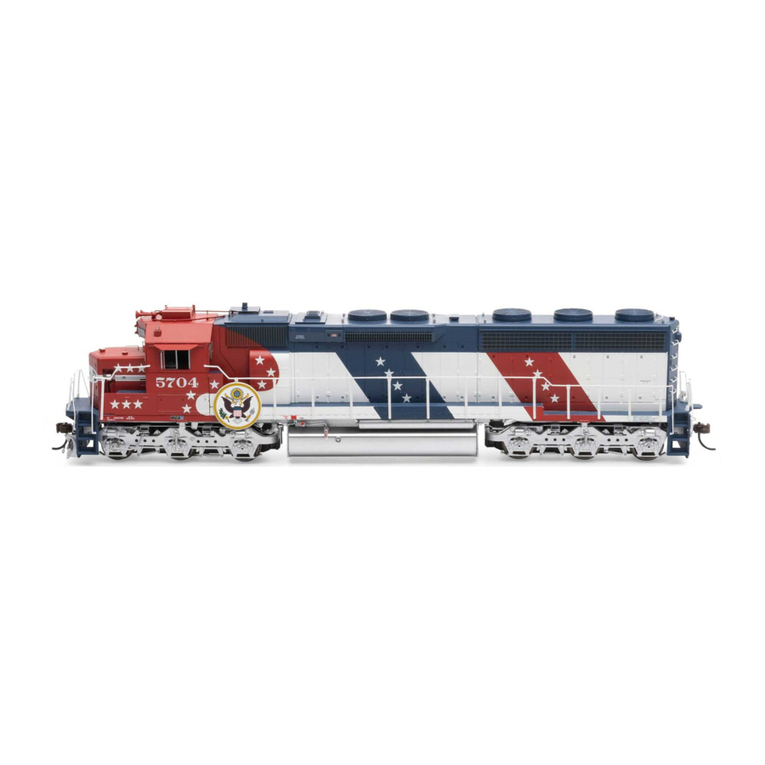
Athearn
Athearn Genesis SD45-2 user manual

Disney
Disney IMAGICADEMY AC-940 quick start guide
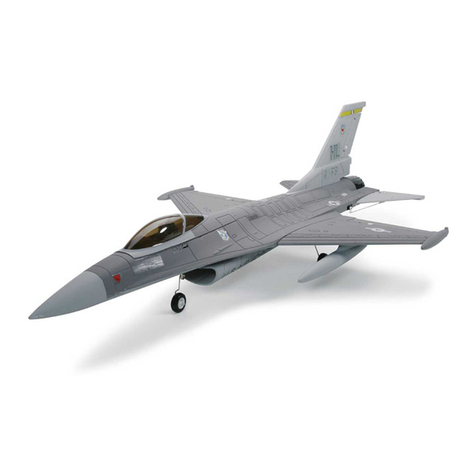
FMS
FMS FMM005PGRY F-16 Falcon operating manual

Betzold
Betzold Kiga-Konstruktion 761416 manual
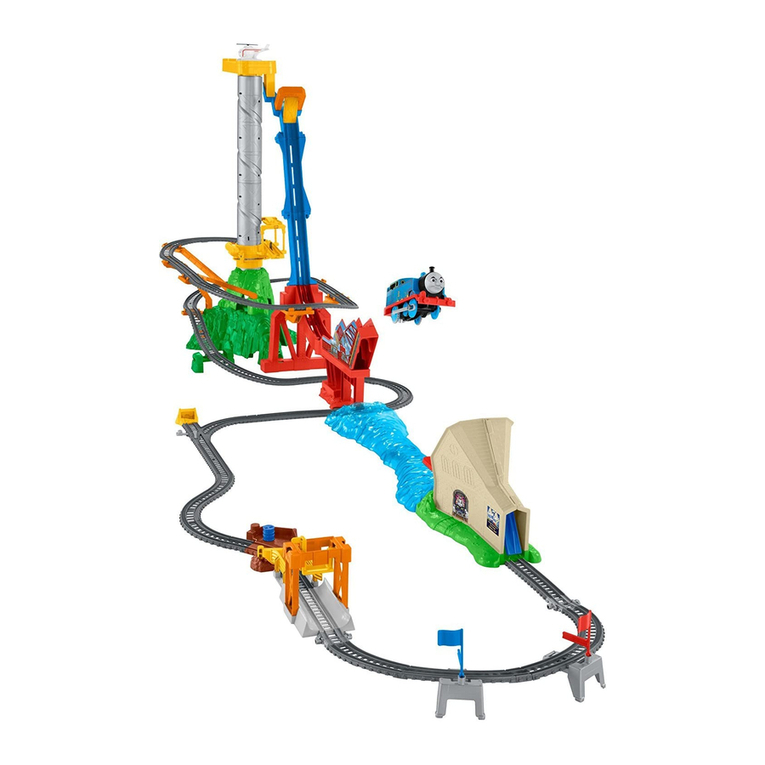
Fisher-Price
Fisher-Price Thomas & Friends TRACK MASTER SKY-HIGH BRIDGE... instructions

Nickelodeon
Nickelodeon Donnie Teenage Mutant Ninja Turtles manual
